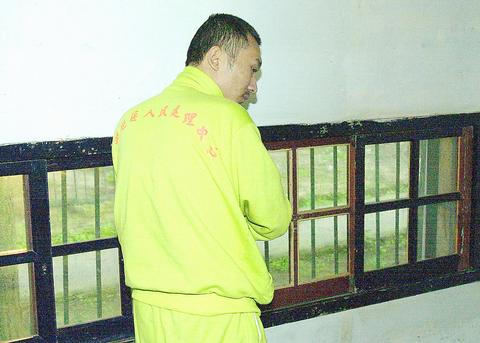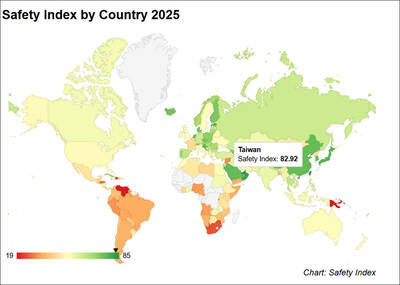In the wake of Chinese hijacker Gao Jun (
However, Lai Hsieh-yi (

PHOTO: CHIANG YING-YING, TAIPEI TIMES
"They [the MOJ and the prison] won't let him go back because he's such a troublemaker," he said.
Gao Jun was one of 16 Chinese who hijacked 12 Chinese domestic flights to Taiwan seeking political asylum in a so-called "hijacking fever" that occurred between April 1993 and June 1994. Armed only with a scalpel, Gao single-handedly hijacked a Chinese Northern Airlines MD-82 jet on a Qingdao to Fuzhou flight on Dec. 8, 1993.
After serving over two-thirds of his 10-year sentence, Gao was paroled on Feb. 19 and was sent to the Hsinchu refugee camp, where he was put on probation to await repatriation to China.
As soon as Gao arrived at the refugee camp he started a hunger strike -- the purpose of which was not clear, Lai said.
"He wants to draw attention and distinguish himself by not cooperating. He used to refuse repatriation; now he says he wants to go back [to China] soon. But I wonder if, when we're to send him back, he might resist again," Lai said.
Citing the concern that Gao's mood might be disturbed, Lai declined a request by the Taipei Times to interview the hijacker, but allowed reporters to see him outside the railings of his cell. Inmates typically live together in large bunk dormitories and are only placed in single-person cells as a security measure or for punishment when they break certain regulations.
Gao looked sane and well. Knowing there was a photographer outside, he sat or stood with his back constantly to the door. When Lai reproached him for not eating, he replied, "I said I don't eat; I just don't."
Gao's hunger strike has now moved into its 15th day, and the refugee camp today plans to have him force-fed by doctors for a third time.
Lai said Gao continues to resist every instruction and knocks over his food tray at meals.
Gao is the last of the 16 hijackers to receive parole and to be transferred to the Hsinchu refugee camp. However, he is by no means the only hijacker to have given camp officials a hard time.
As Gao's probation officer, Lai said it is his duty to report Gao's breach of the conduct rules to the MOJ via the Bureau of Immigration and suggest that Gao's parole be revoked. But Lai said he had tried such a move with another hijacker and failed.
In July 1999, hijacker Qi Dachuan
It has been widely reported by the media that the hijackers have caused significant trouble while in prison. For example, Gao is reported to have swallowed toothbrushes and a thermometer. Hunger strikes, riots and fights in the prison were also frequently reported.
"It is understandable that the prison wants them to stay here until repatriation," Lai said.
The most notable and shocking act of the hijackers took place on Feb. 8, 1999, when three of them repeated the crime. On their pre-repatriation flight from Hsinchu to Kinmen with six other hijackers, Yang Mingde (楊明德), Lin Wenqiang (林文強) and Wang Zhihua (王志華) injured Jan Jyh-horng (詹志宏), deputy secretary general of the Straits Exchange Foundation, with a sharp iron weapon and demanded that the plane be flown to Guam.
The attempt failed and the trio were brought back to Taiwan and convicted of hijacking a second time. They are now in the process of appeals.
Several officials were disciplined over the incident, including the refugee camp director, who was replaced because he was deemed to have been negligent in failing to prevent the trio from making the weapon and taking it on board the plane.
The state watchdog Control Yuan also formally condemned the National Police Administration and demanded the refugee camp enhance the management of hijackers being held on probation.
The reasons for hijackers' inclination to be emotionally frustrated are multifold, successive directors of the refugee camp have said.
First, unlike other inmates, most of whom are illegal immigrants, the hijackers will still face further trials and harsh punishments after they go back to China.
It was reported that the first repatriated Chinese hijacker, Huang Shugang (
Former camp directors also said that by escaping China the hijackers expected to receive a hero's treatment in Taiwan, as was the case for their counterparts during the Cold War era. However, the change of history put them instead behind bars, and they found the reality hard to accept.
Besides, Lai said, some hijackers see themselves as superior to ordinary illegal immigrants. "They regard themselves as coming to Taiwan with a brave act and a political belief and they believe they are different from others who came here on boats just to get a job," Lai said.
"Therefore, some of them don't get along very well with other inmates."
As Lai gave the Taipei Times reporters a tour of a secure zone dormitory, an inmate shouted: "Sir! Someone hit me!"
The man who shouted was Han Shuxue (
Han was sentenced to 11 years and was paroled and sent to the refugee camp in February 1999. Li has already been sent back to China. Lai said Han has been noisy for more than a month this time.
"He has been very fussy and likes to make complaints against camp staff and other inmates," Lai said, "However, his situation is not very serious and what we do is admonish him."
There are now six hijackers waiting to be repatriated in the camp, excluding Yuan Bin (
Lai said the couple behaves very well in the camp and that they are allowed to visit each other weekly.

AIR SUPPORT: The Ministry of National Defense thanked the US for the delivery, adding that it was an indicator of the White House’s commitment to the Taiwan Relations Act Deputy Minister of National Defense Po Horng-huei (柏鴻輝) and Representative to the US Alexander Yui on Friday attended a delivery ceremony for the first of Taiwan’s long-awaited 66 F-16C/D Block 70 jets at a Lockheed Martin Corp factory in Greenville, South Carolina. “We are so proud to be the global home of the F-16 and to support Taiwan’s air defense capabilities,” US Representative William Timmons wrote on X, alongside a photograph of Taiwanese and US officials at the event. The F-16C/D Block 70 jets Taiwan ordered have the same capabilities as aircraft that had been upgraded to F-16Vs. The batch of Lockheed Martin

GRIDLOCK: The National Fire Agency’s Special Search and Rescue team is on standby to travel to the countries to help out with the rescue effort A powerful earthquake rocked Myanmar and neighboring Thailand yesterday, killing at least three people in Bangkok and burying dozens when a high-rise building under construction collapsed. Footage shared on social media from Myanmar’s second-largest city showed widespread destruction, raising fears that many were trapped under the rubble or killed. The magnitude 7.7 earthquake, with an epicenter near Mandalay in Myanmar, struck at midday and was followed by a strong magnitude 6.4 aftershock. The extent of death, injury and destruction — especially in Myanmar, which is embroiled in a civil war and where information is tightly controlled at the best of times —

Taiwan was ranked the fourth-safest country in the world with a score of 82.9, trailing only Andorra, the United Arab Emirates and Qatar in Numbeo’s Safety Index by Country report. Taiwan’s score improved by 0.1 points compared with last year’s mid-year report, which had Taiwan fourth with a score of 82.8. However, both scores were lower than in last year’s first review, when Taiwan scored 83.3, and are a long way from when Taiwan was named the second-safest country in the world in 2021, scoring 84.8. Taiwan ranked higher than Singapore in ninth with a score of 77.4 and Japan in 10th with

SECURITY RISK: If there is a conflict between China and Taiwan, ‘there would likely be significant consequences to global economic and security interests,’ it said China remains the top military and cyber threat to the US and continues to make progress on capabilities to seize Taiwan, a report by US intelligence agencies said on Tuesday. The report provides an overview of the “collective insights” of top US intelligence agencies about the security threats to the US posed by foreign nations and criminal organizations. In its Annual Threat Assessment, the agencies divided threats facing the US into two broad categories, “nonstate transnational criminals and terrorists” and “major state actors,” with China, Russia, Iran and North Korea named. Of those countries, “China presents the most comprehensive and robust military threat